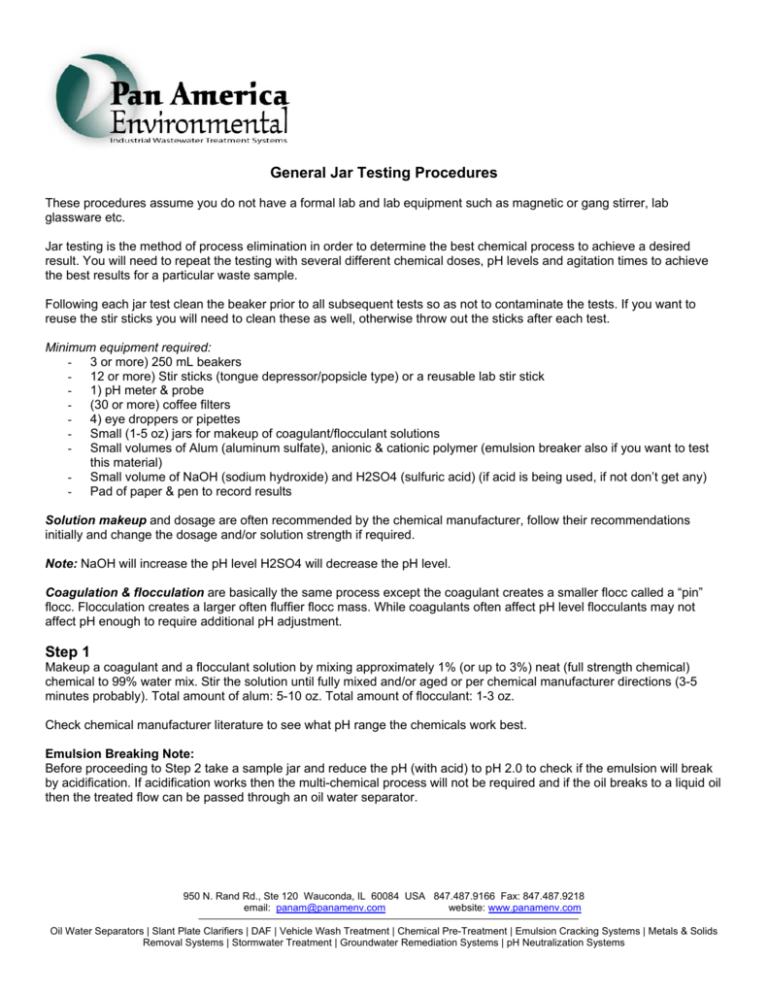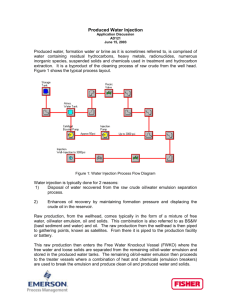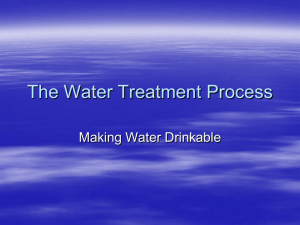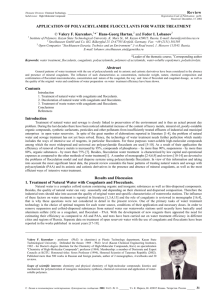General Jar Testing Procedures Step 1
advertisement

General Jar Testing Procedures These procedures assume you do not have a formal lab and lab equipment such as magnetic or gang stirrer, lab glassware etc. Jar testing is the method of process elimination in order to determine the best chemical process to achieve a desired result. You will need to repeat the testing with several different chemical doses, pH levels and agitation times to achieve the best results for a particular waste sample. Following each jar test clean the beaker prior to all subsequent tests so as not to contaminate the tests. If you want to reuse the stir sticks you will need to clean these as well, otherwise throw out the sticks after each test. Minimum equipment required: - 3 or more) 250 mL beakers - 12 or more) Stir sticks (tongue depressor/popsicle type) or a reusable lab stir stick - 1) pH meter & probe - (30 or more) coffee filters - 4) eye droppers or pipettes - Small (1-5 oz) jars for makeup of coagulant/flocculant solutions - Small volumes of Alum (aluminum sulfate), anionic & cationic polymer (emulsion breaker also if you want to test this material) - Small volume of NaOH (sodium hydroxide) and H2SO4 (sulfuric acid) (if acid is being used, if not don’t get any) - Pad of paper & pen to record results Solution makeup and dosage are often recommended by the chemical manufacturer, follow their recommendations initially and change the dosage and/or solution strength if required. Note: NaOH will increase the pH level H2SO4 will decrease the pH level. Coagulation & flocculation are basically the same process except the coagulant creates a smaller flocc called a “pin” flocc. Flocculation creates a larger often fluffier flocc mass. While coagulants often affect pH level flocculants may not affect pH enough to require additional pH adjustment. Step 1 Makeup a coagulant and a flocculant solution by mixing approximately 1% (or up to 3%) neat (full strength chemical) chemical to 99% water mix. Stir the solution until fully mixed and/or aged or per chemical manufacturer directions (3-5 minutes probably). Total amount of alum: 5-10 oz. Total amount of flocculant: 1-3 oz. Check chemical manufacturer literature to see what pH range the chemicals work best. Emulsion Breaking Note: Before proceeding to Step 2 take a sample jar and reduce the pH (with acid) to pH 2.0 to check if the emulsion will break by acidification. If acidification works then the multi-chemical process will not be required and if the oil breaks to a liquid oil then the treated flow can be passed through an oil water separator. 950 N. Rand Rd., Ste 120 Wauconda, IL 60084 USA 847.487.9166 Fax: 847.487.9218 website: www.panamenv.com email: panam@panamenv.com Oil Water Separators | Slant Plate Clarifiers | DAF | Vehicle Wash Treatment | Chemical Pre-Treatment | Emulsion Cracking Systems | Metals & Solids Removal Systems | Stormwater Treatment | Groundwater Remediation Systems | pH Neutralization Systems Step 2 Coagulation - - - Agitate sample to suspend solids in storage container, pour 250 m/L into beaker. Check starting pH, record this pH measurement. Using eye-dropper add 10 drops of coagulant, agitate until flocc forms. Approximate drop from eyedropper is 10 ppm, so the initial dosage is 100 ppm. Check pH to see if this coagulant affects pH. If the pH is outside the range the coagulant works best in, add a slight amount of either NaOH or H2SO4 until pH is within range. Carefully add one of these chemicals so you do not overshoot the pH point. Agitate 2-3 minutes, if nothing occurs repeat test with higher dosage(s) until a strong reaction occurs. Reaction occurs: the material forms obviously visible flocculated masses and has gathered the solids into the flocculated mass to the point where the visible solids in the water are reduced or are gone and the water clarity increases. The masses will take on the color of the solids. Stop agitation, allow flocc to settle or float, record results and describe whatever occurs Repeat this process adding more or less coagulant until you capture the majority of the solids. Once a successful test is achieved begin Step 3. Step 3 Flocculation - - - Use coagulated sample, agitate to re-suspend the pin flocc. Using eye-dropper add 4 drops (40 ppm) of flocculant, agitate until flocc forms. Check pH to see if this flocculant affects pH. If the pH is outside the range the coagulant works best in, add a slight amounts of either NaOH or H2SO4 until pH is within range. Carefully add one of these chemicals so you do not overshoot the pH point. Agitate 2-3 minutes, if nothing occurs repeat test with higher dosage(s) until a strong reaction occurs. Reaction occurs: the material forms large visible flocculated masses and has gathered the pin flocc into the flocculated mass to the point where the pin flocc in the water are reduced or are gone and the water clarity increases. The masses will take on the color of the pin flocc. Stop agitation, allow flocc to settle or float, record results and describe whatever occurs Repeat this process adding more or less flocculant until you capture the majority of the pin flocc. Once a successful test is achieved record results. Place multiple coffee filters inside a clean beaker and slowly drain the sample through to remove the flocculated masses. It will drain quickly at first and will then slow down as more flocc plugs the filter paper. Look at the filtered water sample and visually estimate the solids reduction. If you are not satisfied with the result repeat the entire jar test changing dosages until you get a satisfactory result. Once you have a satisfactory process you can save the filtered flocc materials and weigh them to determine the solids/chemical weight resulting from the test. Emulsion Breaking With Alum Alum is often used in breaking of emulsions. If the sample looks translucent whitish/grayish/brownish if solids are present (similar to skim milk) you may have an emulsion. By following the same coagulation directions above you can break the emulsion. You may need higher concentrations, so try multiple tests with gradually increasing concentrations. Although each emulsion is different and light emulsions may require less alum concentrations you may find that in order to break an emulsion with alum you may need between 200 & 400 ppm concentration. The coagulation directions above are typically based on a 10-20% alum solution, if your solution strength is greater your testing concentration can be lower. 950 N. Rand Rd., Ste 120 Wauconda, IL 60084 USA 847.487.9166 Fax: 847.487.9218 website: www.panamenv.com email: panam@panamenv.com Oil Water Separators | Slant Plate Clarifiers | DAF | Vehicle Wash Treatment | Chemical Pre-Treatment | Emulsion Cracking Systems | Metals & Solids Removal Systems | Stormwater Treatment | Groundwater Remediation Systems | pH Neutralization Systems








